Open reduction internal fixation
1. Principles
Because NOE type I injuries represent a noncomminuted fracture, the goal should be to achieve a perfect reduction of the frontal process of the maxilla.
The fracture then requires internal fixation to maintain its proper position. This could include 1-, 2-, or 3-point fixation.
The proper repositioning of the fragment and thus the medial canthal tendon is crucial to the final result.
Great care should be taken when considering placing plates anterior to the medial canthal ligament as these may be visible through the thin overlying skin.
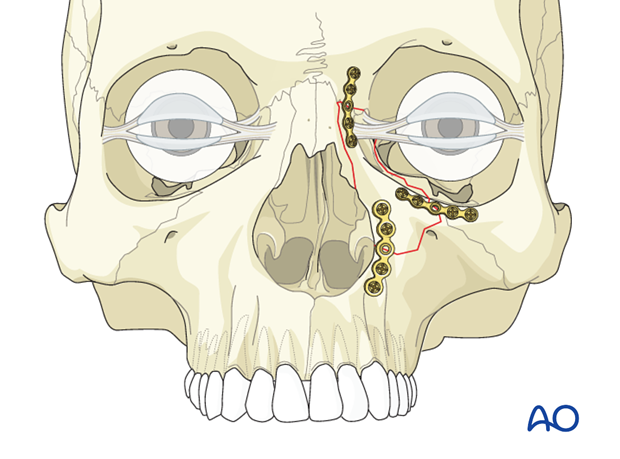
Nasal bone involvement
If the nasal bones are also fractured, they should be reduced.
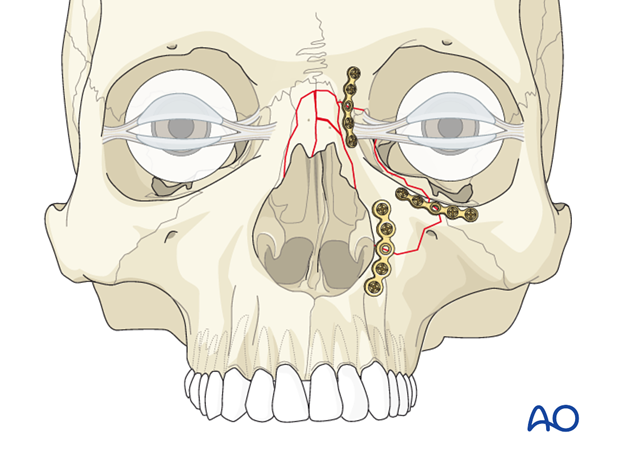
2. Selection of approach
The most common access for reduction of NOE type I fractures includes the extended glabellar and the maxillary vestibular approaches. Existing lacerations can also be used. The lower eyelid transcutaneous or lower eyelid tranconjuctival approaches may be used in case of associated zygomatic fractures. For isolated unilateral NOE type I fractures a coronal approach is usually not necessary.
3. Reduction
NOE type I fractures are usually not difficult to reduce because they are not comminuted.
While visualizing the reduction of the bone fragment through one surgical approach, the surgeon must continually recheck the reduction through the other surgical incisions.
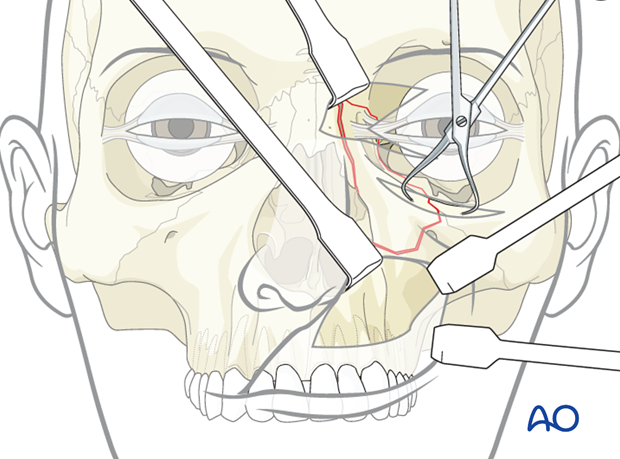
4. Fixation
General consideration
Displaced NOE type I fractures require internal fixation to maintain proper position. This could include 1-, 2-, or 3-point fixation.
NOE type I fractures that are hinged at the frontomaxillary suture, repositioning of the frontal process of the maxilla by rotating the infraorbital segment nasally may only require one point exposure and fixation at the piriform aperture via a maxillary vestibular incision.
NOE type I fractures that require fixation at the frontomaxillary/frontonasal junction may require an extended glabellar approach or a transconjunctival approach with medial extension for fixation at this fracture site. For isolated unilateral NOE type I fractures a coronal approach is usually not necessary.

Placement of first plate
The first plate is generally placed inferiorly, from the fractured fragment to the solid maxillary bone of the piriform aperture. This is performed through a vestibular incision.
In some cases the bone fragment may be hinged superiorly so that inferior fixation may be sufficient.
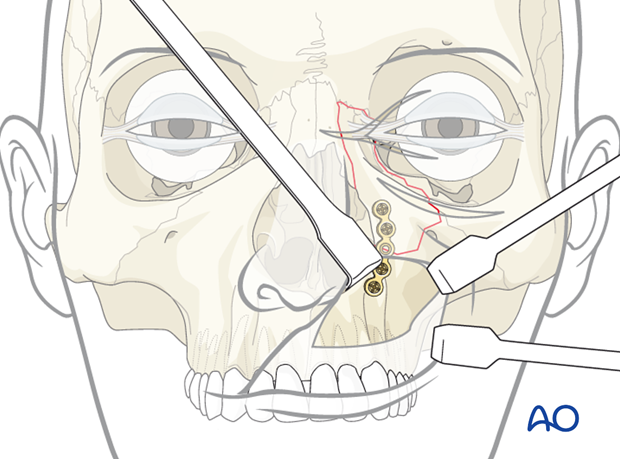
Placement of a second plate
If two-point fixation is needed, the second plate is placed at the frontonasal suture.
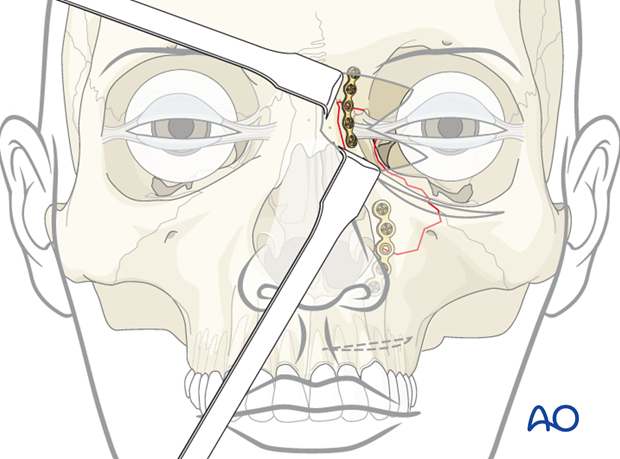
Placement of third plate (if necessary)
A third plate may be necessary in case of associated fractures.
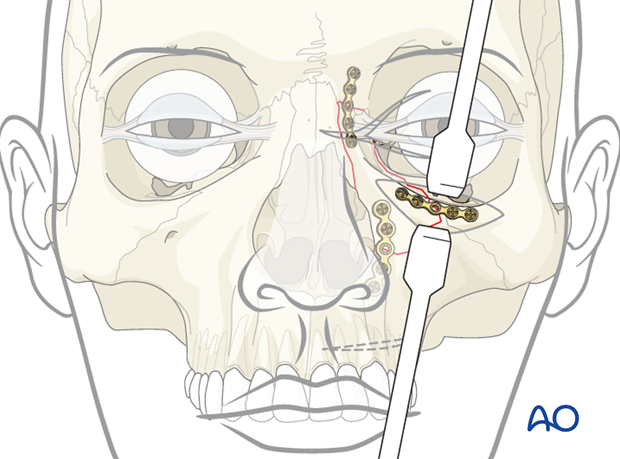
Pearl: preliminary fixation of first plate if more than one plate is needed
A recommendation would be to place and loosely tighten just one screw on each side of the fracture allowing for minimal movement of the segment. This allows some 3-dimensional movement and correction for a further reduction during the other 2-point fixation. After the other point or points have been fixated, the final screws will then be placed in the first plate.
5. Soft tissues
A problem with NOE fractures is that even with a perfect bony reduction there may be a lack of definition in the medial canthal area (Epicanthal fold). Many surgeons advocate placing some sort of external nasal splints at the end of the procedure. If one chooses to use this technique, extreme caution is recommended. Patients will commonly have significant postoperative edema in this area, surgical incisions and lacerations can be present. If the splints are placed too tight, the patient is at risk of having skin necrosis in the medial canthal area.
This technique may be more relevant with the increased complexity of the NOE fracture. It may not be as applicable with a simple type I fracture where there has been minimal degloving of the soft tissues from the bone in the medial canthal area. It may be more beneficial in type II and type III fractures where there has been more comminution associated with a greater need for degloving of the soft tissues to achieve adequate reduction and fixation.
However, NOE type I fractures usually give good result as far the definition in the medial canthal area.
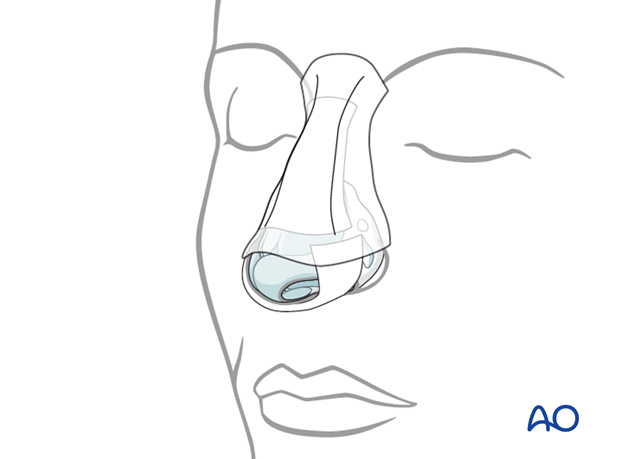
6. Aftercare following management of NOE fractures
Evaluation of the patient’s vision
Evaluation of the patient’s vision is performed as soon as they are awakened from anesthesia and then at regular intervals until they are discharged from the hospital.
A swinging flashlight test may serve in the unconscious and/or noncooperative patient; alternatively electrophysiological examination has to be performed but is dependent on the appropriate equipment visual evoked potential (VEP).
Postoperative positioning
Keeping the patient’s head in a raised position both preoperatively and postoperatively may significantly improve edema and pain.
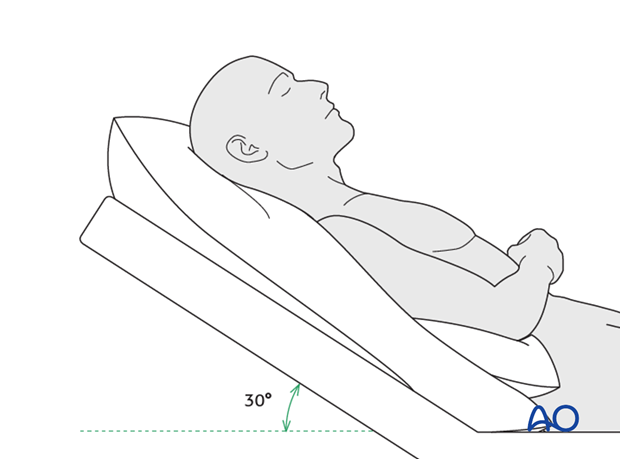
Nose-blowing
To prevent orbital emphysema, nose-blowing should be avoided for at least 10 days following NOE fracture repair.
Medication
The use of the following perioperative medication is controversial. There is little evidence to make strong recommendations for postoperative care.
- No aspirin for 7 days (nonsteroidal antiinflammatory drugs (NSAIDs) use is controversial)
- Analgesia as necessary
- Antibiotics (many surgeons use perioperative antibiotics. There is no clear advantage of any one antibiotic, and the recommended duration of treatment is debatable.)
- Nasal decongestant may be helpful for symptomatic improvement in some patients.
- Steroids, in cases of severe orbital trauma, may help with postoperative edema. Some surgeons have noted increased complications with perioperative steroids.
- Ophthalmic ointment should follow local and approved protocol. This is not generally required in case of periorbital edema. Some surgeons prefer it. Some ointments have been found to cause significant conjunctival irritation.
Ophthalmological examination
Postoperative examination by an ophthalmologist may be requested. The following signs and symptoms are usually evaluated:
- Vision
- Extraocular motion (motility)
- Diplopia
- Globe position
- Visual field test
- Lid position
- If the patient complains of epiphora (tear overflow), the lacrimal duct must be checked
- If the patient complains of eye pain, evaluate for corneal abrasion
Note: In case of postoperative diplopia, ophthalmological assessment is needed to identify the cause. Hess-chart testing should be performed if diplopia persists.
Postoperative imaging
Postoperative imaging has to be performed within the first days after surgery. 3-D imaging (CT, cone beam) is recommended to assess complex fracture reductions. In centers where intraoperative imaging is available postoperative imaging can be performed at a delayed time.
Wound care
Remove sutures from skin after approximately 5 days if nonresorbable sutures have been used.
Apply ice packs (may be effective in a short term to minimize edema).
Avoid sun exposure and tanning to skin incisions for several months.
Diet
Diet depends on the fracture pattern and patients condition but there are usually no limitations.
Clinical follow-up
Clinical follow-up depends on the complexity of the surgery, and the patient’s postoperative course.
In all patients with NOE trauma, all the following should be periodically assessed:
- Globe position
- Double vision
- Other vision problems
- Nasal airway status
Other issues to consider are:
- Facial deformity (incl. asymmetry)
- Sensory nerve compromise
- Problems of scar formation
- Anosmia
- Epiphora and dacryocystitis
Implant removal
Implant removal is rarely required. It is possible that this may be requested by patients if the implant becomes palpable or visible. In some countries it will be more commonly requested. There have been cases where patients have complained of cold sensitivity in areas of plate placement. It is controversial whether this cold sensitivity is a result of the plate, a result of nerve injury from the original trauma, or from nerve injury due to trauma of the surgery. Issues of cold sensitivity generally improve or resolve with time without removal of the hardware.
Special considerations
Travel in pressurized aircraft is permitted 4 – 6 weeks postoperatively. Mild pain on descent may be noticed. However, flying in non-pressurized aircraft should be avoided for a minimum of 12 weeks.
No scuba diving should be permitted for at least 12 weeks. Additionally, the patient should be warned of long term potential risks.












